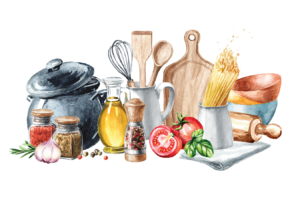 These five vegetables may not be your usual go-tos, but they pack a powerful punch when it comes to nutrition…and they taste good too. So jazz up your menu and get adventurous in the kitchen!
These five vegetables may not be your usual go-tos, but they pack a powerful punch when it comes to nutrition…and they taste good too. So jazz up your menu and get adventurous in the kitchen!
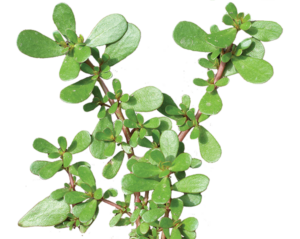 Common Purslane
Common Purslane
Common purslane (Portulaca oleracea), also known as little hogweed or pursley, is a drought-tolerant summer annual weed (perineal in tropical regions) that can grow under most adverse conditions and thrives in sunny, nutrient-rich, sandy soils. Purslane is native to India and Persia, but is now commonly found throughout the world. Purslane is considered a weed because it can grow just about anywhere, and you’ll often finding it cropping up between cracks in the sidewalk or concrete, throughout your yard, and in your garden beds. It can reach six inches in height and two feet in width and grows into a dense circular mat of glossy succulent red-colored stems and green paddle-shaped leaves. Mid-to-late summer, it develops small bright yellow flowers.1
Though many people consider purslane a weed, its succulent leaves and stems are edible. In fact, these lemony, crunchy plants are not only delicious, they are highly nutritious and are considered by some to be a superfood.2 Purslane contains the highest amount of vitamin A among green leafy vegetables, and as much as five times more omega-3 fatty acids than spinach. Purslane has recently been identified as the richest vegetable source of alpha-linolenic acid, an essential omega-3 fatty acid. It also contains vitamin C and B-complex vitamins (e.g., riboflavin, niacin, and pyridoxine) and is an excellent source of dietary minerals, including potassium, magnesium, calcium, phosphorus, and iron.2
Chances are purslane is growing wild right out in your backyard. It is generally considered safe to pick and consume wild purslane—just make sure to rinse the plants carefully to remove any potential pesticides, and don’t pick plants that are growing right next to streets or other places where it might come into contact with pollutants. To ensure sure you’ve correctly identified a purslane plant, break open one of its stems. If a milky substance oozes out, it is not purslane—it is poisonous and should not be eaten.
To prepare purslane, snip the plant at the main stem using scissors when gathering. Fill the sink with cold water and immerse the entire plant in the water. Swish the plant around in the water to remove any dirt. Snip off and remove thick stems. Dry the purslane with paper towels or spin it in a lettuce spinner. It can be stored a plastic bag in the fridge for a few days and even frozen for up to six months (after blanching). Purslane leaves can be tossed raw into a salad or cooked as a side dish.3 The stems and leaves are also mucilaginous (gelatinous/viscous), meaning they can be used to thicken soups and stews.1
Check out our recipe for purslane salad HERE.
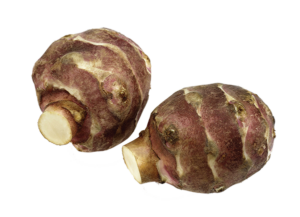 Sunchokes
Sunchokes
Sunchokes (Helianthus tuberosus) are also known as Jerusalem artichokes, though they have nothing to do with Jerusalem nor are they truly artichokes. Native to North America, sunchokes are the lumpy, brown-skinned tuber of a variety of sunflower. The tubers are a few inches long and resemble ginger root, but, once peeled, have a similar texture to that of potatoes.4 Unlike potatoes, sunchokes can be eaten raw, but are generally prepared in much the same manner as potatoes, parsnips, or turnips (e.g., boiled, grilled, mashed, roasted, or fried).5 While the skins of sunchokes are edible, they can be a bit stringy, so the skins are usually removed prior to consuming.5
The sunchoke is a good source of inulin, a prebiotic fiber that stimulates the growth of bifidobacteria, a type of good bacteria that reside in the human intestinal tract…but beware! Inulin might make some people a little…um…gassy. The sunchoke is an excellent source of potassium, packing more potassium per 100 grams than even bananas. The sunchoke is also a good source of the B vitamins, thiamine in particular, which play important roles in nervous system and muscle functioning, and carbohydrate metabolism.6
Sunchokes are easy to grow. They are perinneals in Zones 2 to 8, but can be grown as annuals in Zones 9 and 10 (though they won’t get as big). The tubers can be planted in the spring and then harvested in the fall after the first hard freeze. The plants get 6 to 12 feet tall, and each plant has a two-foot spread underground, so they are best planted in a sunny area where it is ok for them to spread. They will continue to produce more and more tubers each year, which turn into more sunchoke plants, so be careful…they really can take over an area. For those with backyard gardens on the smaller size, planting sunchokes in large containers might be the best way to go.7,8
Check out our recipe for roasted sunchokes HERE.
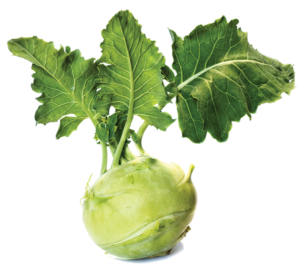 Kohlrabi
Kohlrabi
Kohlrabi (Brassica oleracea), also known as a German turnip, is a biennial plant thought to be native to northern Europe.9 The whole kohlrabi plant—except for the root—is edible and can be eaten raw or cooked. It is a cruciferous plant, like cabbage, broccoli, and kale, and looks like a cross between a turnip and a head of cabbage. The pale green bulb is 3 or 4 inches in diameter (about the size of an orange) with a tall crown of pale green stems and big leaves jutting from the top. Like other cruciferous vegetables, it has a slightly sweet, slightly bitter/peppery flavor.10
When preparing Kohlrabi, the thick outer skin should first be removed. The vegetable is versatile. Like cabbage, it can be grated into slaw or chopped into small matchsticks and tossed raw into salad or into the wok for stir fry. Like a turnip or potato, it can be boiled, grilled, mashed, or roasted. The greens can be chopped and added raw to salad or cooked like you would spinach or collards.10
Kohlrabi is an excellent source of fiber and vitamin C. It is a good source of vitamin B6, potassium, magnesium, manganese, folate, and protein.11
Kohlrabi is a cool weather vegetable and is easy to grow. It can be planted in early spring and harvested in early summer or planted late summer and harvested in late fall. In regions with mild winters, kohlrabi can be left in the ground and harvested throughout the winter. Kohlrabi has a large root system, so it is not suitable for container growing.12
Check out our recipe for sautéed kohlrabi HERE.
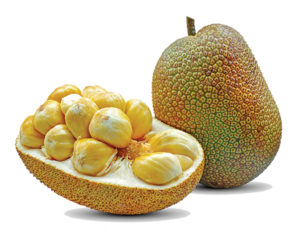 Jackfruit
Jackfruit
The jackfruit tree (Artocarpus heterophyllus) is native to tropical Asia, but is widely grown throughout wetland tropics. It is known for its large fruit and durable wood. The fruit of the jackfruit tree is considered the largest tree-born fruit in the world, reaching upwards of 2 feet in length and 40 pounds in weight, sometimes even bigger.13 According to Guinness World Records, in 2016, the largest jackfruit was recorded at 22 inches long and 52 inches in circumference, with a weight of 94 pounds and 2.9 ounces.14 The oblong fruit has a yellow-green (unripe) to brownish (ripe) hard, bumpy rind that, when ripe, encloses several bright yellow fleshy pods, each of which houses a large seed. When unripe, the flesh of the jackfruit is white, and the pods and seeds are much smaller.13
The jackfruit can be consumed when it is unripe or ripe. The stringy texture and neutral flavor of the unripe fruit has made jackfruit a popular plant-based substitute for meat (though its protein content is minimal). Ripe jackfruit, on the other hand, has a very sweet taste similar to pineapple or mango, though still chewy and stringy.15
Jackfruit is a good source of fiber, potassium, and antioxidants, including vitamin C, B vitamins, calcium, and magnesium, as well as flavonoids and lignans, which are thought to have anti-inflammatory properties.15
Your local grocery store may or may not offer fresh jackfruit in its product department; but you will likely find fresh in-season jackfruit at Whole Foods or other similar specialty or gourmet grocery stores or the local Asian grocery store. Other grocery store chains, such as Trader Joes, may not sell fresh jackfruit, but may offer it in canned form. If buying canned jackfruit, read the label to determine what type of liquid the fruit was packed in, as this will indicate whether the fruit was ripe or unripe when canned. If the label says the fruit was packed in brine or water, this indicates it was canned in its unripened state, and thus will be white in color and neutral in taste. This form is ideal for use in savory dishes or as a plant-based substitute for meat. If the fruit was packed in syrup, this indicates it was ripe when canned, and thus will be bright yellow in color and have a fruity, sweet taste. This form is ideal for use in sweet dishes, deserts, or smoothies.
Check out our recipe for jackfruit taquitos HERE.
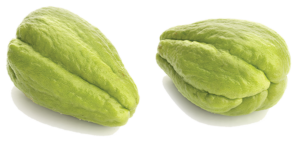 Chayote Squash
Chayote Squash
Chayote squash (Sechium edule) is a member of the gourd family. Like other squash, it is technically a fruit, but more commonly prepared as a vegetable. It is native to Mexico, and, while widely available in the Southwestern United States, it may be less commonly found in the other regions of the country.16
Chayote squash is similar in shape and size to a pear. Its thin skin is light to dark green in color, with pale green flesh underneath. It has a neutral flavor, and all parts of the vegetable are edible (i.e., skin, seeds, flesh), making chayote squash a versatile addition to any meal.16
Chayote squash is considered a nutrient-dense food because it is low in calories and simple carbohydrates, but high in nutrients, and it offers a number of nutritional benefits. Chayote squash is excellent source of fiber, vitamin B, vitamin C, potassium, amino acids, magnesium, calcium, and antioxidants. Most of these nutrients are found in the skin of the chayote squash, so consuming this vegetable with the skin on is ideal.16 Chayote squash can be consumed raw or cooked. It can be roasted, grilled, fried, or boiled. It is suitable for both savory and sweet dishes.16
If your normal grocery store does not carry chayote squash, you can likely find it at specialty or gourmet grocery stores, such as Whole Foods, or at your local farmers market. Keep in mind that chayote squash is a warm-to-hot region vegetable, so if you live in colder regions of the country, local farmers markets may only carry them for limited periods of time; however, in warmer climates, chayote squash may be available most of year, if not year-round.17
While chayote squash is easy to grow in a home vegetable garden, it requires at least four frost-free months from planting to harvest, making it unsuitable for in-ground planting in Zones 6 or lower in the United States. For these lower zones, chayote squash can be planted in containers, which could then be moved inside before first frost, but it is a vigorous climber and will need a sturdy trellis, and container plants tend to produce less fruit. Chayote squash can be overwintered outdoors in Zones 7 or higher. When sowing chayote squash, the entire squash is planted, fat end down in the ground, with the stem just level with the soil’s surface.17
Check out our recipe for chayote stir fry HERE.
Sources
1. PennState Extension site. Dandelion and common purslane: ubiquitous edible weeds. 23 Feb 2021. https://extension.psu.edu/dandelion-and-common-purslane-ubiquitous-edible-weeds. Accessed 14 Mar 2022.
2. Udain K, Juraimi AS, Hoosain S. Purslane weed (Portulaca oleracea): a prospective plant source of nutrition, omega-3 fatty acid, and antioxidant attributes. Scientific World J. 2014; 2014: 951019.
3. The Washington Post site. How to pick and prepare purslane. https://www.washingtonpost.com/archive/lifestyle/food/2002/06/19/how-to-pick-and-prepare-purslane/5109fc88-1282-4072-8539-a2321798ac2b/. Accessed 14 Mar 2022.
4. BBC Goodfood site. Jerusalem artichoke. https://www.bbcgoodfood.com/glossary/jerusalem-artichoke-glossary. Accessed 14 Mar 2022.
5. Covington L. What are Jerusalem artichokes. Updated 28 Jul 2021. The Spruce Eats site. https://www.thespruceeats.com/what-are-jerusalem-artichokes-and-how-to-use-them-4783505. Accessed 14 Mar 2022.
6. Heal with Food site. Jerusalem Artichokes: Health Benefits & Nutritional Properties. https://www.healwithfood.org/health-benefits/jerusalem-artichokes.php. Accessed 14 Mar 2022.
7. Joybilee Farm site. How to grow sunchokes for perpetual harvest. https://joybileefarm.com/grow-sunchokes/#:~:text=It’s%20easy%20to%20grow%20sunchokes,center%20of%20your%20flower%20bed. Accessed 15 Mar 2022.
8. Neverman L. Before you plant sunchokes, you need to read this post. 18 Jan 2017. Common Sense Home site. https://commonsensehome.com/before-you-plant-sunchokes/. Accessed 15 Mar 2022.
9. Root W. A kohlrabi by any other name. 6 Oct 1977. The Washington Post site. https://www.washingtonpost.com/archive/lifestyle/1977/10/06/a-kohlrabi-by-any-other-name/9c526db0-0a60-4278-ae37-37b608de04f3/. Accessed 15 Mar 2022.
10. Berg F. Everything to know about kohlrabi. 27 Jan 2022. Food Network site. https://www.foodnetwork.com/how-to/packages/food-network-essentials/kohlrabi. Accessed 15 Mar 2022.
11. Davidson K. Get to know kohlrabi, a versatile vegetable. Updated 2 Dec 2021. Healthline site. https://www.healthline.com/nutrition/kohlrabi. Accessed 15 Mar 2022.
12. Bonnie Plants site. Growing Kohlrabi. https://bonnieplants.com/blogs/how-to-grow/growing-kohlrabi. Accessed 15 Mar 2022.
13. Encyclopedia Britannica site. Jackfruit. https://www.britannica.com/plant/jackfruit. Accessed 21 Mar 2022.
14. Guinness World Records site. Heaviest jackfruit. 23 Jun 2016. https://www.guinnessworldrecords.com/world-records/78709-heaviest-jackfruit. Accessed 21 Mar 2022.
15. Cleveland Clinic site. What is Jackfruit and is it healthy? 11 Dec 2020. https://health.clevelandclinic.org/what-is-jackfruit-and-is-it-healthy/. Accessed 21 Mar 2022.
16. Hill A. 10 impressive benefits of chayote squash. 9 Apr 2019. https://www.healthline.com/nutrition/chayote-squash. Accessed 21 Mar 2022.
17. Albert S. How to grow chayote. https://harvesttotable.com/how_to_grow_chayote/. Accessed 21 Mar 2022.





